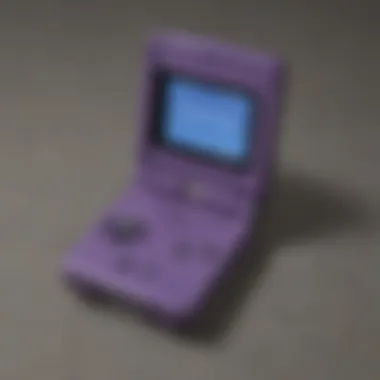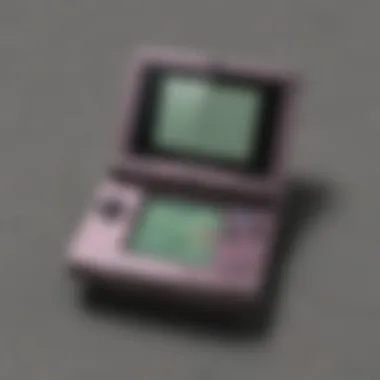The Nintendo Game Boy Advance SP: A Deep Dive into Its Legacy


Intro
The Nintendo Game Boy Advance SP remains an iconic device in the realm of handheld gaming. Launched in 2003, it was the evolution of its predecessor, the Game Boy Advance, with notable enhancements in design and technology. The primary aim of this article is to dissect its various aspects, including its innvative features, impressive game library, and profound impact on gaming culture. Throughout this comprehensive analysis, readers will delve into discussions that illuminate the Game Boy Advance SP's pivotal role in shaping the landscape of portable gaming.
Game Reviews
Gameplay Features and Mechanics
The Game Boy Advance SP was renowned for its user-friendly mechanics that set it apart from earlier models. Providing players with both accessibility and versatility, the controls were intuitive and responsive. The introduction of a clamshell design granted protection to the screen and made it compact for portability. Players could easily engage with various titles, ranging from action-packed adventures to cerebral puzzles. This seamless adaptability contributed profoundly to its acceptance among a wide audience.
Storyline and Quests
The library of games for the Game Boy Advance SP is extensive and rich, presenting a myriad of storylines and quests that engage players from all demographics. Iconic titles such as The Legend of Zelda: The Minish Cap boast immersive narratives that convey deep themes of courage and friendship. Each game intelligently merged compelling storylines with quest objectives that kept players invested, ensuring longevity and enjoyment in gameplay.
Visuals and Sound Design
Equipped with a more refined backlit screen, the Game Boy Advance SP offered improved visuals that were richer in color and detail. This was a significant leap from its predecessors and brought handheld gaming into a new territory of visual fidelity. When it comesd to sound, iconic soundtracks accompanied many of the games, establishing an auditory experience that resonated with the excitement and immersion of gameplay.
Comparison with Previous Titles
Compared to earlier versions of Game Boy, such as the original Game Boy and the Game Boy Color, the SP offered not just enhancements in graphic design and processing power, but also innovations in playability. Essential features, such as the ability to recharge its lithium battery, made the SP notably more user-friendly. Fans of Mario, Zelda, and Pokémon found their experiences much richer, contributing positively to the device's reputation.
This device bridged the gap between casual gaming and dedicated gaming experiences, captivating both sides of the spectrum.
Character Analyses
Popular Characters Overview
Central to the allure of many GBA SP titles are the characters who inhabit them. Renowned characters such as Link and Princess Zelda have undergone evolutions in character design and complexity. These characters often encapsulate core themes central to their respective game narratives, making them favorites for fans.
Character Development and Backstories
Games like The Legend of Zelda series showcase well-crafted character arcs. The characters are not flat; they have richly developed backstories that guide their motivations and emotional journeys. Players engage deeply when they learn about the histories that shape the actions and decisions of these characters, adding richness to the gaming experience.
Role in the Zelda Universe
In the expansive Zelda universe, characters like Link become enduring symbols often mirrored in various narratives. Each iteration elevates the gameplay while respecting the legacy established by prior titles, creating a dynamic feeling of continuity throughout the series.
Fan Theories and Speculations
The Zelda series is ripe with theories that stir considerable discussion among fans. Many enthusiasts speculate on character connections and underlying themes present in the games. These debates further enrich the cultural tapestry surrounding the franchise and highlight the ongoing engagement of the community.
Lore Discussions
Mythology and Worldbuilding
The lore within the Zelda universe is extensive and meticulously crafted. The mythology plays a foundational role in immersive storytelling, helping to contextualize the actions of characters and quests in the games. Each adventure delves deeper into the rich landscape that Nintendo meticulously developed.
Legendary Items and Artifacts
Artifacts like the Triforce are not only pivotal to gameplay but symbolize rich metaphoric undertones that resonate with players. Legendary items often encapsulate themes of power, courage, and wisdom—elements that are reflected in both the characters and gameplay dynamics.
Link to Real-world Mythologies
Many elements within the game echo age-old mythologies from cultures around the world. These inspirations contribute authority to the gameplay while highlighting the narratives' connections to real-world themes, making it relatable for players of all backgrounds.
Timeline Placement and Theories


Much academic discussion has also been devoted to theorizing the timeline placement of various games within the Zelda series. The timeline speculates where each game's events occurred, providing conclusive material for fans interested in unraveling the series' sequential layers.
Gameplay Strategies
Combat Techniques and Tips
Players often seek strategies to upscale their combat efficiency, master weapon techniques, and counter-specific enemy patterns. Sharing tactical insights about optimal weapon use has highlighted the compatibility of strategy and mechanics, enhancing the overall gaming experience.
Puzzle Solutions and Walkthroughs
Each game within the GBA library often presents puzzles that are critical to progressing through quests. Players benefit from shared contentieneal walkthroughs that guide them through complex problems, suggesting techniques or tools aid them in successful gameplay.
Collectibles and Side Quest Guides
Identifying andous collectingables provides depth to gameplay. The GBA hostess an array of side quests aimed to incite exploratory adventures beyond the main narrative. Having an understanding of where to find these items enriches the player’s experience.
Boss Battles Tactics and Strategies
Sorting out the strategies for approaching boss characters often takes a blend of skill and careful study. Seasoned players share strategies, from equipment to combat maneuvers, essential for achieving victory against these formidable foes.
In summary, the Nintendo Game Boy Advance SP, builds upon its predecessors to offer a unique experience in portable gaming. It combines a thoughtful design, captivating narratives, and an impressive focus on community-driven discussions that enrich the gaming culture. Its legacy persists well beyond its time, echoing in the hearts of players and in the DNA of modern handheld gaming devices.
Closure
Through a thorough exploration of its features and impact, the enduring legacy of the Game Boy Advance SP is established as a cornerstone in the evolution of gaming — leading to an access date system which shapes the engage in-balanced response to history research as immersion gaming.
Go to Nintendo, and Reddit for more details.
Prelims to the Game Boy Advance SP
The Nintendo Game Boy Advance SP stands as a significant milestone in the realm of handheld gaming. This subsystem represents Nintendo's capability to adapt and innovate within a competitor-heavy market. The aim of this analysis is not merely to remind the reader of nostalgic childhood memories but rather to provide a clear dissection of its design, technology, and cultural relevance. By understanding the launch and legacy of the GBA SP, enthusiasts can appreciate its influential role in shaping modern gaming.
Historical Context of Handheld Gaming
Handheld gaming has a long and evolving history. In the late 1970s and 1980s, early devices like the Mattel Autoworld captured initial interests and paved the way for personal portability. As technology advanced, platforms like the Game Boy series began to take precedence, allowing gamers to revel in full-fledged game experiences away from traditional consoles. By the time the GBA SP hit the market, it entered a landscape already rich with expectations regarding gameplay, performance, and battery life. Prior attempts laid the groundwork and established benchmarks for what consumers would anticipate from future innovations.
Historically, handheld gaming devices were either simplistic or extremely bulkily. Nintendo's GBA SP struck a balance combining design with functionality.
Nintendo's Evolution in Portable Consoles
Nintendo has historically prioritized innovation in its gaming products. The initial Game Boy, released in 1989, opened the floodgates for mobile gaming. Over the years, every release refined the experience further. With subsequent models like the N Game Boy Color and Game Boy Advance, players eagerly embraced advancements in graphics and handheld capabilities. The GBA SP represented the zenith of this evolutionary path, fusing elegance in design with enhanced playability. It illustrated how Nintendo mastered the art of creating portable objects that not only fulfilled but exceeded user desires.
The GBA SP's introduction was critical. It marked a transition; the device was sleek with a clam-shell shape that not only protected the screen, but made it more pocket-friendly. This progressive shift displayed Nintendo’s understanding of consumer expectations, and it positioned the GBA SP as not just a gaming console but as a fashion statement. The innovation did not stop at aesthetics; the usability improvements made notably shifted the public perception of handheld systems at large. Users could finally carry powerful gaming systems with ease and style.
Design and Features
The design and features of the Nintendo Game Boy Advance SP are crucial for understanding its role in portable gaming. This handheld console was created not just as a gaming device but also as a compact platform for entertainment. Its portability and ergonomics played a pivotal role in its widespread appeal. The diverse enhancements in design and features are compelling evidence of Nintendo’s dedication to improving user experience, setting new standards in the handheld market.
Compact Design and Flip Screen
The compact design of the Game Boy Advance SP is a definitive feature that distinguishes it from its predecessors and competitors. Unlike the original Game Boy Advance, which had a flat structure, the SP introduced a flip-screen. This design allowed for better protection of the screen, making it more durable. The dimensions of the GBA SP also made it extremely portable. Users could easily slip it into backpacks or even pockets. This factor enhanced its functionality, ensuring gamers could enjoy their games anywhere, from public transport to family trips. Moreover, the opening mechanism provided the advantage of immediate access to gameplay upon a simple flip, removing the need for cumbersome lids or covers. The overall construction is ergonomic, enabling long hours of play without discomfort. This compact feature made the handheld feel substantial yet lightweight.
Improvements in Display Technology
The Game Boy Advance SP adopted significant advancements in display technology when compared to its predecessors. One of the most notable differences was the incorporation of a frontlit screen. Previous models often struggled in outdoor lighting conditions. However, this new technology enhanced visibility, allowing users to play in various light settings, including bright sunshine and dim interiors. Furthermore, the SP introduced a backlit version that exceeded user expectations, markedly improving color contrast and enhancing detail. The representation of graphics in popular games was crystal clear. Enhanced color and pixel density meant the handheld could showcase a remarkable range of titles with vivid artwork and atmospheres that engaged players. These improvements reflect a developmental milestone in portable display technology, making the GBA SP convenient for users and capable of delivering an engaging gaming experience.
Battery Life and Power Management


Battery life is an essential aspect that often influences a user’s choice of gaming handheld. The Nintendo Game Boy Advance SP robustly addressed this with its compact lithium-ion rechargeable battery. Users could expect approximately 10 hours of gameplay on a single charge with the backlight turned off, a hugely beneficial feature for on-the-go gaming. Additionally, with the backlight activated, players could still enjoy up to 5-6 hours of continuous play. This marked a substantial improvement in power management from older handheld systems. The SP was designed to maximize battery efficiency while guaranteeing performance, an accomplishment not all processors and systems could achieve successfully during that time. The convenience of the built-in battery reduced the hassle of dealing with replaceable batteries, which were a frequent downside for previous models. The device also provided a clear on-screen power indicator, allowing players to monitor their charge levels and plan sessions effectively.
The design and features of the Game Boy Advance SP not only enhanced the gaming experience but also solidified Nintendo's position as a leader in portable gaming systems.
Technical Specifications
The technical specifications of the Nintendo Game Boy Advance SP provide insight into its overall functionality and influence regarding portable gaming. These specifications encompass several critical aspects such as processing power, memory capabilities, and connectivity features. Understanding these details is essential to grasp the device’s performance and its capacity to support various gaming experiences. Each element plays a significant role in determining how well the device responds to both casual and demanding game types, fundamentally enhancing user engagement and satisfaction.
Processor and Performance
The Nintendo Game Boy Advance SP is equipped with a 32-bit custom ARM7TDMI processor. This provides ample power for graphics rendering and game processing. The performance of this CPU enabled a shift in handheld gaming. At the time of its release, this was particularly beneficial for players looking for a more advanced gaming experience in a compact form.
The processor operates at a clock speed of 16.78 MHz. While this may seem modest by modern standards, it effectively managed games with complexity and enriched environments. The overall result was smoother gameplay and a richer game experience that maintained excitement, even in graphically demanding titles.
The GBA SP shows that even moderate speed can yield admirable performance when combined with thoughtful game design.
Memory and Storage Options
The Game Boy Advance SP is equipped with 32 KB of internal RAM and supports game cartridges that can range from 256 KB to 32 MB in size, with the ability to save game data on cartridges, quite innovative at the time. This allows players to have significant data space for various game situations. The effective utilization of storage means that even the most evolving gameplay can adapt and progress without limitations.
Furthermore, GBA SP allows using a flash linker, enabling players to load games from their PC directly. This aspect added a layer of flexibility previously unavailable in handheld devices and greatly enhanced the overall well-rounded capability of memory utility.
Connectivity Features
In terms of connectivity, the Game Boy Advance SP featured a link cable port, allowing localized multiplayer experiences. This port can support daisy chaining for multiple devices, enabling engaging competition or cooperative play among friends. Additionally, the ability to connect to the Nintendo GameCube broadened opportunities for unique cross-platform gameplay. Players could enjoy exclusive content and features integrating gameplay effectively between different devices.
These specifications outline the GBA SP as more than just a portable game console; it's a landmark achievement blending performance with practical features. This profound relationship between the technical specifications and gaming experience explains GBA SP's remarkable position in portable gaming history.
Game Library
The Game Boy Advance SP boasts a vast and diverse game library that significantly contributes to its status in the handheld gaming niche. This aspect reveals how the device did not merely serve as hardware; it became a crucial gateway to countless gaming experiences. The game library embodies the creativity and innovative spirit within the gaming industry. Importantly, games available on the GBA SP are cherished by many.
Moreover, the library showcases not only iconic franchises but also a multitude of genres for all types of players. In essence, the success and longevity of the Game Boy Advance SP are directly linked to the quality and variety of its game offerings. This critical component highlights the human aspect of gaming, where shared experiences bloom through engaging stories and intricate gameplay.
Iconic Games and Franchises
Numerous games have defined the Game Boy Advance SP's landscape. Titles like The Legend of Zelda: The Minish Cap and Pokémon Ruby and Sapphire have left lasting impressions on fans. Such games are not just entertainment; they elevate the medium by combining captivating narratives with brilliant muisc and engaging gameplay mechanics.
Franchises that migrated to the GBA SP did so seamlessly, building on existing lore while inviting a new generation of players. Other noteworthy titles such as Metroid Fusion and Castlevania: Aria of Sorrow demonstrated expansive world-building and standout artistry. These franchises not only cemented their legacy; they nestled themselves in the hearts of enthusiasts who eagerly awaited each release.
Diverse Genres in Portable Gaming
One of the impressive qualities of the Game Boy Advance SP is its capability to cater to various interests in gaming. The library stretches across many genres, ensuring that there is something for every player. Action, role-playing, puzzle, eacoٽي, and even simulation genres coexist within this singular platform.
This diverse library helps broaden the appeal of portable gaming itself. From the strategic battles in games like Fire Emblem to the pure adventure offered in Advance Wars, each genre interaction enriches gaming culture overall. When players seamlessly shift between genres, they explore new skills and discover fresh narratives. The thematic diversity elevates game choices beyond mere entertainment, creating an experience that is genuinely enthralling.
Influence of Third-Party Developers
While Nintendo undeniably shaped the GBA SP’s identity, the contribution of third-party developers is significant. Companies like Capcom, Square Enix, and Konami placed their stamps on the device with memorable releases. The resulting collaborations introduced a variety of unique gameplay experiences, providing a polished backdrop to the core Nintendo-themed offerings.
Games like Mega Man Battle Network and Final Fantasy Tactics Advance came to life due to these third-party influences. These collaborations enhanced the depth of the gaming library, ensuring it remained appealing and current. Gamers had access to boundaries that stretched doubts and pushed creativity’s limits. This fusion between Nintendo's core products and third-party contributions plays a crucial role in the GBA SP’s longevity and cultural relevance.
"The GBA SP library was not just an afterthought—it was an invitation to worlds beyond imagination, bred from hopes of diverse developers and Nintendo's nurturing hands."
In summary, the Game Boy Advance SP's game library is a complex tapestry woven from varied influences. It includes iconic titles, genre diversity, and vital support from third-party creators, all of which contribute to its acclaim and lasting importance in portable gaming history.
Cultural Impact


The Nintendo Game Boy Advance SP represents a key milestone in the landscape of portable gaming, contributing significantly to its cultural footprint. This section examines how the GBA SP has permeated popular culture and solidified the legacy of handheld gaming through invention, design, and the it faced on subsequent devices.
Game Boy Advance SP in Popular Culture
The Game Boy Advance SP did not just serve as another device for gaming; it transformed into an icon within various cultural contexts. Its sleek design, compact build, and illuminated screen revitalized gaming for many users, becoming a preferred mode of entertainment. The distinct foldable design made it easily portable, allowing players to engage with their favorite titles anywhere their lives took them.
The GBA SP made guest appearances across numerous media forms, from films to music. Countless references emerged that acknowledged the device, reflecting its impact. For instance, musicians and filmmakers included it to resonate with audiences, suggesting that gaming had entered mainstream conversation. This cultural normalization opened doors for further essential references in movies or songs, seeing fans celebrating the system alongside mainstream tech.
Furthermore, elements from beloved games on the platform, such as The Legend of Zelda: The Minish Cap or Metroid Fusion, reinforced the GBA SP's importance in pop culture. These games nstead of being merely digital experiences, became part of the shared cultural lexicon, influencing other creative expressions off games.
The Game Boy Advance SP became more than just a console—it altered how portable gaming was perceived across generational divides.
Legacy of Portable Gaming
The structural evolution introduced by the Game Boy Advance SP also set a precedent that other handhelds would follow. Today’s mobile gaming platforms owe a great deal to what the GBA SP accomplished in terms of both hardware and software. Light gaming experiences paving sustainable market directed a natural audience transition towards companies like Sony and Microsoft as they entered the space.
The impact of the GBA SP is especially significant when considering its influence on game design and portability intrinsic to mobile gaming. Subsequent devices no longer solely focused on pushing graphical advances; the GBA SP laid the groundwork for experiences that are enriching despite their generation's technical constraints. Features like simplification in control schemes grew from this for more families to engage with gaming.
In summary, the legacy of the Nintendo Game Boy Advance SP paves formative patters recognized universally. Its blend of design, popularity, and a remarkably broad game library enabled future touchscreen and cloud-based games. Therefore, it contributes persistently to a vibrant, evolving genre fueled by its extraordinary beginning.
Comparative Analysis
GBA SP vs.
Other Handheld Consoles
The Game Boy Advance SP can be compared to several handheld consoles released around the same time. Key competitors include the Sony PlayStation Portable and the Nintendo DS. Each of these systems provided unique gaming experiences and designs. The Game Boy Advance SP brought features that had been either absent or minimal in its rivals.
Design Considerations
The GBA SP had a flip design. This allowed for a compact form, protecting the screen and controls. In contrast, the PlayStation Portable had a wider layout with no protection for the screen when not in use. The Nintendo DS introduced a dual-screen and touch UI, making it innovative for handheld gaming. However, it carried more complexity for developers and players alike. Thus, the GBA SP stands out for its simplicity and assured portability.
Technical Performance
When assessing graphics and processing power, it is noticeable that each console had strengths in different areas. The GBA SP was powered by a 32-bit ARM processor, suitable for its game library. In comparison, the Sony PlayStation Portable featured impressive capabilities, supporting advanced 3D graphics not possible on the GBA SP. The Nintendo DS again took a differing path by focusing more on innovative gameplay rather than raw graphics performance. These factors also impacted audience preference, often aligning with nostalgic and gamestyle needs.
Game Library Variety
The Game Boy Advance SP had a vast library of games available. Classics like The Legend of Zelda: The Minish Cap and Metroid Fusion drew fans. Other systems provided their classics, captures of another genre flavor. The Nintendo DS had 3D games that showcased expansive worlds and different play mechanics. i
Role in the Transition to Modern Handhelds
The GBA SP's role in transitioning to modern handheld devices was crucial. It laid a significant groundwork that later models and concepts would build on. Understanding this trajectory gives insight into how gaming shapes future consoles.
Innovations in Gaming Experience
The GBA SP prioritized the user experience, making gameplay accessible. The introduction of features like a backlight was pivotal. It had addressed player demands for improved visibility. While newer systems improved graphical fidelity, none without considerable battery sacrifice could provide such prolonged gameplay. Additionally, its smaller design encouraged a focus on diverse genres, aligning how players approached the portable market.
Lasting Influence on Design Philosophy
Here, it is essential to note more holistic contributions. The design philosophies of newer systems tend to reference ideas from the GBA SP, resulting in centering comfort and functionality. The notion that form should serve the gameplay experience is alive in consoles like the Nintendo Switch, demonstrating that lessons were learned. The launch of the GBA SP signalled a commitment to quality gameplay rather than expensive (but lesser functional) gadgets.
In terms of impact, the GBA SP solidified the qualities desired in portable consoles while opening avenues for creativity in the industry.
Looking forward, the pathways laid by the GBA SP continue to significant development. Handheld gaming has evolved yet still retains echoes of its groundwork. The lessons learned during its life contribute meaningfully to game development and console manufacturing today.
Culmination
The conclusion holds a significant place in this article, tying together all discussions around the Nintendo Game Boy Advance SP. It serves to encapsulate the device’s lasting impact on both the gaming industry and players across various generations. Emphasizing key elements can enlighten readers and offer a broader understanding of why the GBA SP remains a pivotal handheld gaming console.
Lasting Legacy of the Game Boy Advance SP
The Game Boy Advance SP has left an indelible mark on gaming history. Launched in 2003, it succeeded its predecessors by merging portability with enhanced graphical capabilities. Its compact form, impressive game library, and user-friendly features contributed to its status as a favorite among gamers. Furthermore, the introduction of a front-lit screen marked an important evolution in gaming technology which many handhelds upon its release attempted to emulate.
Players remember nostalgic classics like The Legend of Zelda: The Minish Cap and Metroid Fusion. These games went beyond entertainment, providing cultural references still cherished in today’s conversations among enthusiasts. The GBA SP’s impact transcends its lifespan, influencing game design and portable console development.







